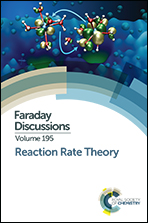Unimolecular dissociation of peptides: statistical vs. non-statistical fragmentation mechanisms and time scales
Abstract
In the present work we have investigated mechanisms of gas phase unimolecular dissociation of a relatively simple dipeptide, the di-proline anion, by means of chemical dynamics simulations, using the PM3 semi-empirical Hamiltonian. In particular, we have considered two activation processes that are representative limits of what occurs in collision induced dissociation experiments: (i) thermal activation, corresponding to several low energy collisions, in which the system is prepared with a microcanonical distribution of energy; (ii) collisional activation where a single shock of hundreds of kcal mol−1 (300 kcal mol−1 in the present case) can transfer sufficient energy to allow dissociation. From these two activation processes we obtained different product abundances, and for one particular fragmentation pathway a clear mechanistic difference for the two activation processes. This mechanism corresponds to the leaving of an OH− group and subsequent formation of water by taking a proton from the remaining molecule. This last reaction is always observed in thermal activation while in collisional activation it is less favoured and the formation of OH− as a final product is observed. More importantly, we show that while in thermal activation unimolecular dissociation follows exponential decay, in collision activation the initial population decays with non-exponential behaviour. Finally, from the thermal activation simulations it was possible to obtain rate constants as a function of temperature that show Arrhenius behaviour. Thus activation energies have also been extracted from these simulations.
- This article is part of the themed collection: Reaction Rate Theory

 Please wait while we load your content...
Please wait while we load your content...